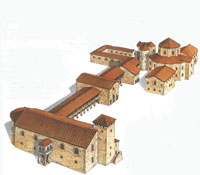ASIDE: CHARLEMAGNE'S CAPITULARIES793 -
Capitularies The Capitulary de Villis (793) issued by Charles on royal administrationis merely one in a series of Carolingian documents intended to provide administrative order in the Frankish realm (some 65 capitularies, containing 1151 articles, were introduced during his reign).

- Charlemagne promulgating a 'capitulary'.

- Charlemagne's signature
PalacesAt the heart of the royal administration is the '
palatium' (palace court), several of which were set up throughout the realm, the most important of which is Aachen (Aix-la-Chapelle in French, Aquisgrana in Italian), built in a hot springs spa by Pepin in the 760s. Other Frankish palaces include Quierzy, Ingelheim, Diedenhofen, Heristal, Ponthion, Nymwegen, Attigny, etc.

- Charlemagne's palace at Aachen
Charlemagne's throne (Aachen) (
side viewCharlemagne's palatine chapel
- Map of Francia, showing location of the main royal palaces, archbishoprice and abbeys
Each palace is routinely attended by the landed counts and bishops of the region. The king and his itinerant retinue travels from palace to palace, collecting reports and dispensing instructions.
Each palace court has a permanent staff of royal officers, including:
- "count-palatine" (in charge of judicial matters),
- "grand chaplain" (head of the palace chapel, in charge of clerical matters),
- "chancellor" (head of notaries and clerks, keeper of the seals, often dependent on the grand chaplain)
- "chamberlain" (in charge of the king's treasury, assisted by a stable of accountants ('sacelliairi', 'fisci'))
- "seneschal"' (in charge of provisioning the palace court and servants ('domestici')),
- "constable" ( head of the palace's military, assisted by 'marshalls')

Charlemagne and a seneschal
Counties.
The realm itself is divided into over two hundred counties, each under the joint jurisdiction of a
count (charged with civil, judicial and military authority) and a
bishop (responsible for spiritual affairs). Both count and bishop are appointed by the king. (Note that the extent of their jurisdiction is the same, just their jobs differ.
The counties are visited four times a year by '
missi dominici' (royal emissaries, usually another roving count-bishop pair), empowered to review their judgments and activities, receive any complaints and remedy any wrong-doing.

- missi dominici
Underneath the count & bishop are the
centenari and
vicars, assigned to every hundred-family district. Three times a year, assisted by a jury of freemen of the district and trained judges ('scabini') dispatched by the count, the centenarius holds a court day to judge all cases presented before him. Those cases that might involve the loss of life, liberty and property of the accused above a certain threshold are kicked upstairs to the count's own court-day.
A
viscount wasn't a territorial lord yet, but a temporary count appoiunted when the actual count was absent or at war.
MarchesCharlemagne never trusted anyone with more than a county and did his utmost to get rid of the old German and Lombard dukes. The only exceptions were the
march-counts ('margraves', 'marquises'), special regional lords instituted by Charles to oversee multiple frontier counties (a "
March") and organize its defenses and support missionary work among foreign tribes. Carolingian marches include:
- Breton March (c.753), straddling Rennes, Nantes & Vannes, to contain & supervise the Celts of Brittany. Legendary paladin Roland (Orlando) was a margrave here.
- March of Gothia (c.759), Narbonne/Septimania, to contain Gascons from west and Spaniards from south. In 795, reorganized and elevated as a supermarch covering the Gascon and Spanish marches.
- Gascon March (c.782), originally the ring of Toulouse, Bordeux and Ferenszac, to contain and supervise the Basques/Gascons after the debacle at Roncesvalles. Later the name for the march covering western Pyrenees (Navarre, Sobarbe, Ribaguerza, etc.)
- Carantanian March (786) - covering Carantanian and southern Slavs (Croats, Slovenes).
- Avar March (796), originally an eastern bulwark against the Avars. Later expanded into Hungary itself.
- Spanish March (c.802), over the Catalonian counties (Barcelona, Gerona, Urgell, etc.) as a bulwark against the Spanish Moors.
- March of Friuli (803), new eastern bulwark complex composed of Friuli, Istria, Styria, Carinthia, Carniola and Dalmatia.
- Saxon march (to contain saxons, evolved into Duchy of Saxony, covering Engern, Westfalia, Eastfalia and Northalbingia).
- Danish march (border against Danes, from which the name "Denmark" evolved).
- Sorb march (Elbe borderland against Slavic Sorbs)
Wary that powerful march-counts may turn against him someday, Charlemagne took the precaution of erecting regional
sub-kingdoms to more closely supervise the powerful march-lords. The sub-kingdoms of Aquitaine, Italy and Bavaria were resurrected for that reason and invested in his own sons.